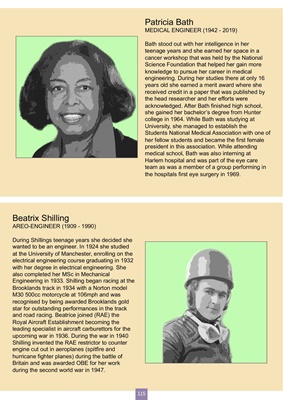
Patricia Bath
MEDICAL ENGINEER (1942 - 2019)
Bath stood out with her intelligence in her
teenage years and she earned her space in a
cancer workshop that was held by the National
Science Foundation that helped her gain more
knowledge to pursue her career in medical
engineering. During her studies there at only 16
years old she earned a merit award where she
received credit in a paper that was published by
the head researcher and her efforts were
acknowledged. After Bath finished high school,
she gained her bachelor's degree from Hunter
college in 1964. While Bath was studying at
University, she managed to establish the
Students National Medical Association with one of
her fellow students and became the first female
president in this association. While attending
medical school, Bath was also interning at
Harlem hospital and was part of the eye care
team as was a member of a group performing in
the hospitals first eye surgery in 1969.
Beatrix Shilling
AREO-ENGINEER (1909 - 1990)
During Shillings teenage years she decided she
wanted to be an engineer. In 1924 she studied
at the University of Manchester, enrolling on the
electrical engineering course graduating in 1932
with her degree in electrical engineering. She
also completed her MSc in Mechanical
Engineering in 1933. Shilling began racing at the
Brooklands track in 1934 with a Norton model
M30 500cc motorcycle at 106mph and was
recognised by being awarded Brooklands gold
star for outstanding performances in the track
and road racing. Beatrice joined (RAE) the
Royal Aircraft Establishment becoming the
leading specialist in aircraft carburettors for the
upcoming war in 1936. During the war in 1940
Shilling invented the RAE restrictor to counter
engine cut out in aeroplanes (spitfire and
hurricane fighter planes) during the battle of
Britain and was awarded OBE for her work
during the second world war in 1947.
115